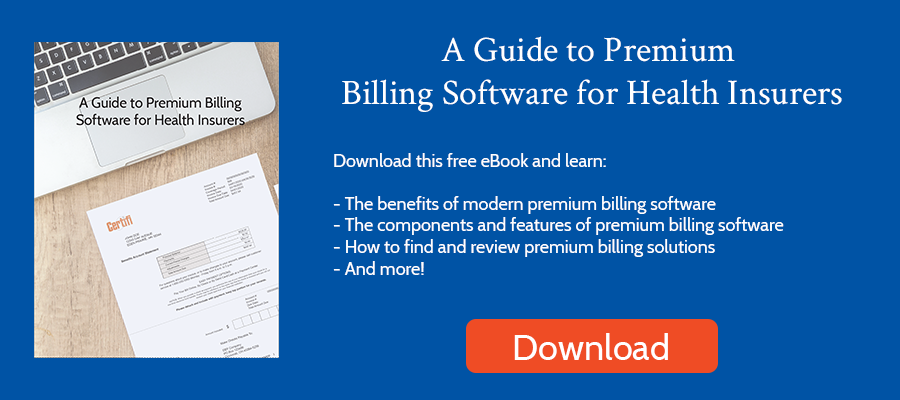When health insurers consider the value of automating their premium billing processes, they usually consider the time saved by the billing and customer service staff. That’s true, automating the billing process can improve the bottom line by turning time-consuming, manual processes into efficient, time-saving ones. But most insurers don’t consider how implementing more automated processes can help them grow their top-line health insurance revenue.
With that in mind, here are three ways automated premium billing software helps grow health insurance revenue:
Eliminate Billing Errors That Cause Customer Churn
Health insurance has been steadily shifting to a member-centric model. With the advent of the ACA‘s individual markets as well Medicare Advantage’s growth, smart health insurers focus on delivering personalized member experiences. If they don’t, the competition will, eroding market share.
Yet, often those experiences don’t take into account member billing. It’s an important touchpoint that can occur as frequently as monthly. According to an American Express 2017 Customer Service Barometer, 33% of Americans say they’d consider switching companies after just a single instance of poor service. Gartner reported that 64% of people find customer experience more important than price. Billing errors eat up customer service time. A single billing error may also cause a member to churn.
Estimates indicate that manual data entry leads to a 3% error rate. So if you’re using manual billing processes, like manually applying SSA payments to a member account, instead of an automated process, you are likely introducing errors that impact the customer downstream. Automated processes can help reduce errors and improve the member experience, limiting churn.
Redeploy Resources to Revenue Generating Activities
The NFL salary cap has had far-reaching ramifications on the way general managers construct their teams. Almost every Super Bowl winner has had a great quarterback, and great quarterbacks are generally the highest-paid players. So building a team around a veteran quarterback who earns a significant portion of a team’s salary cap leaves worse players on the rest of the roster.
But because of the way the NFL structured the salary cap, teams now value QBs on rookie contracts more. Why? The NFL pays players based on where a team drafts them. Even QBs picked first in the draft usually earn less than the top half of QBs. As a result, teams with QBs on a rookie contract can build a deeper, more complete team. They pay a smaller portion of their salary cap to their quarterback. Several teams in the new salary cap era – like the Seahawks with Russell Wilson, the Rams with Jared Goff, and the Chiefs with Patrick Mahomes — made it to the Super Bowl because they were able to build more complete teams. As a result, teams select more quarterbacks in the first round of the draft. They find value at the QB position in the draft spend their cap money on the other players.
Redeploying Your Resources
What does this have to do with automating premium billing? Like an NFL team, your organization only has so many resources. Deploying your limited resources to activities that generate revenue will make you more competitive, just like an NFL team deploying its salary cap to build a deeper team. By automating the billing process with technology, you’ll be able to improve the accuracy of every bill while also redeploying team members to tasks that generate revenue.
For example, sometimes members submit payments without identifying information like their account number. As a result, your staff has to review those checks or check images. Then, they perform a lookup to determine where to apply the check.
Our software automates that process by leveraging machine learning. Instead of a human reviewing the check image, technology does it. A machine performs a lookup using check information and then suggests which account is most likely to have made that payment. A human then reviews that recommendation and decides who made the payment. The machine learns from that human decision, improving future recommendations and further streamlining the process. As a result, we process at least four times as many unidentified checks in the same amount of time, freeing resources for more productive tasks.
Automated Communication Improves the Member Experience
For subscription-based services, up to 40% of customer churn is involuntary. Meaning, it happens when a payment isn’t made. In most cases, the subscriber either didn’t know money was due or had an expired payment method. That’s a remarkably high number and often can be overcome by leveraging effective communication.
Automating your communication process with email and mailed delinquency notifications can help reduce that churn. But it’s also important to communicate how to set up recurring payments as frequently as possible, notify members of any partial payments as well as any failed payments or expiring payment methods. In those communications, include a paragraph about how to make a payment and how to set up recurring payments so future payments aren’t missed. Automatically triggering these communications based on billing and payment events not only saves you time, but effective billing communication can improve premium payment rates, reduce customer churn, and ultimately grow health insurance revenue.
Certifi’s health insurance premium billing and payment solutions help healthcare payers improve member satisfaction while reducing administrative costs.



